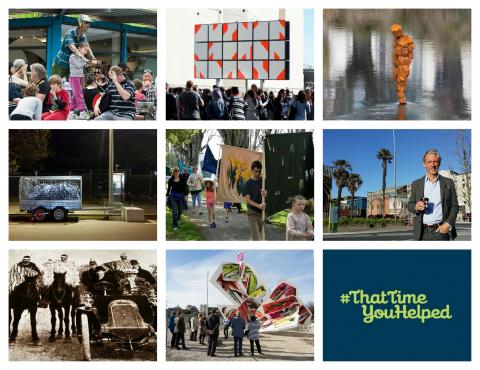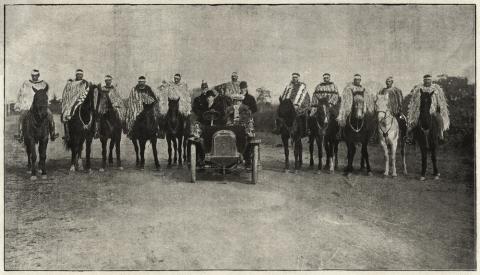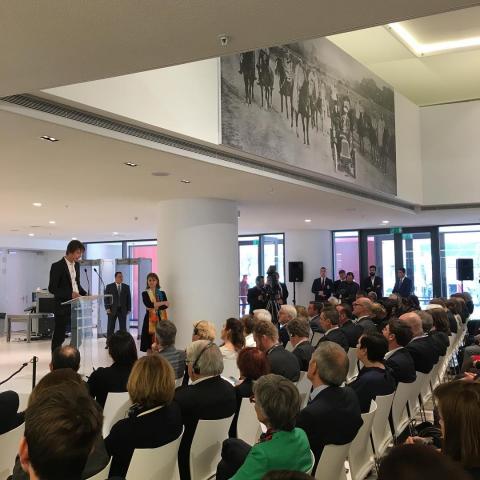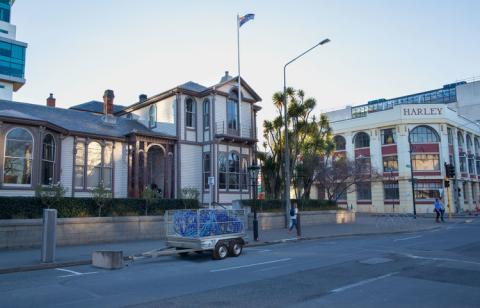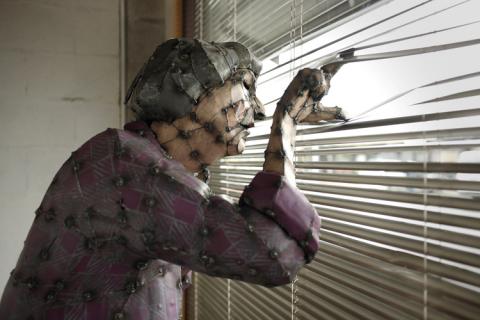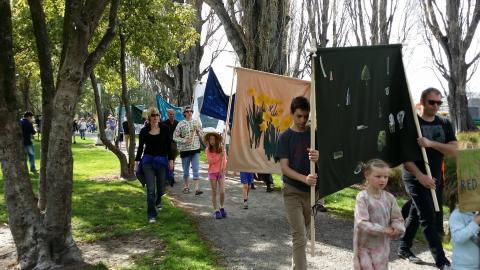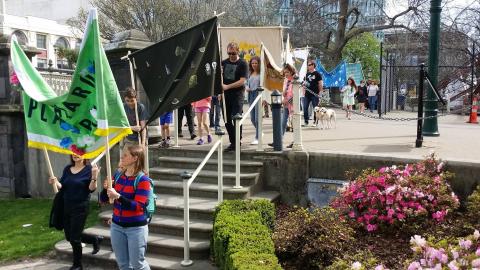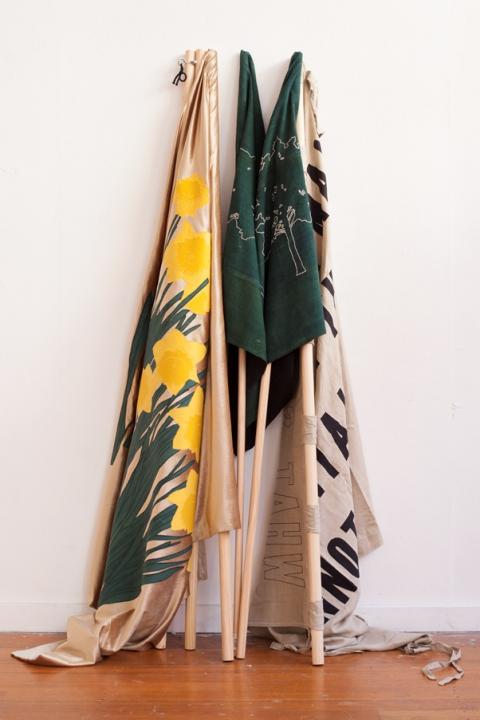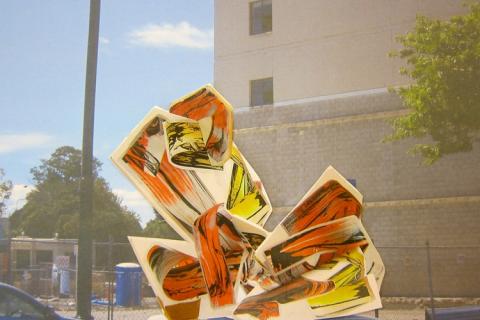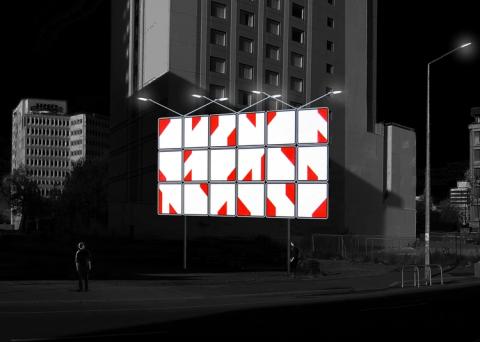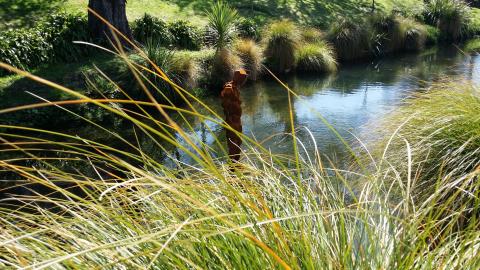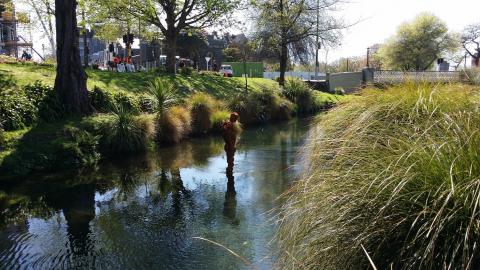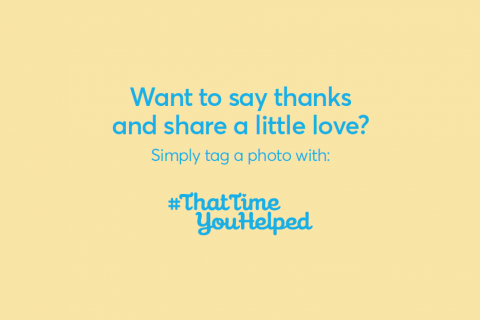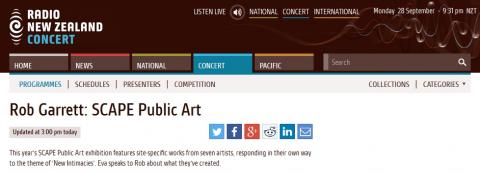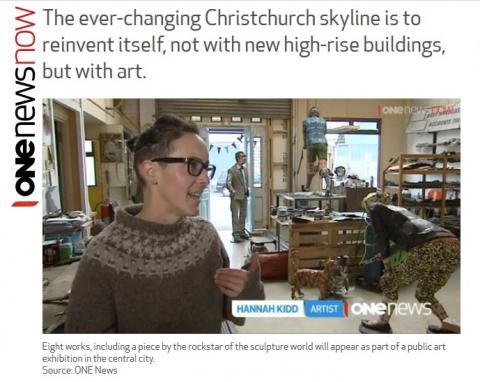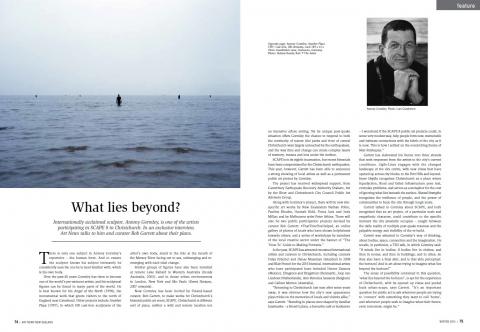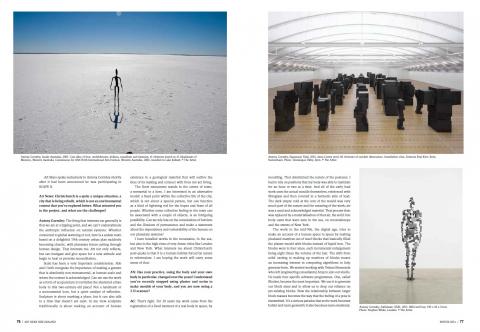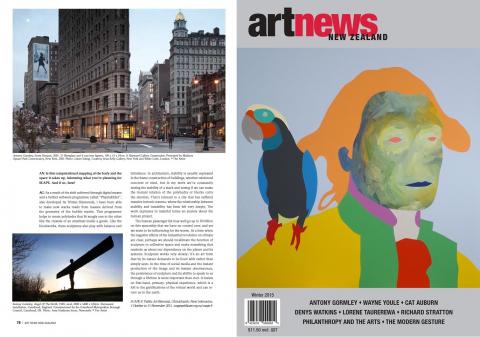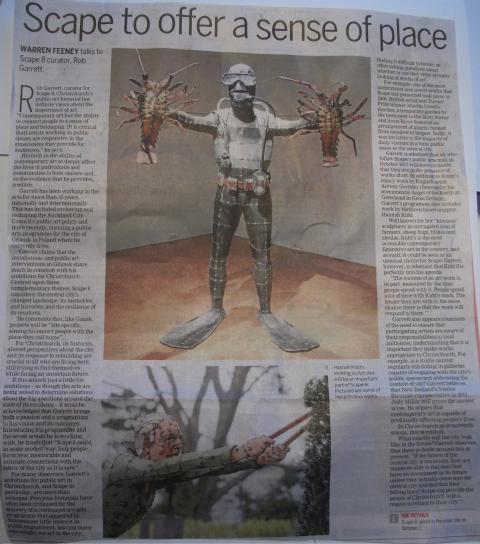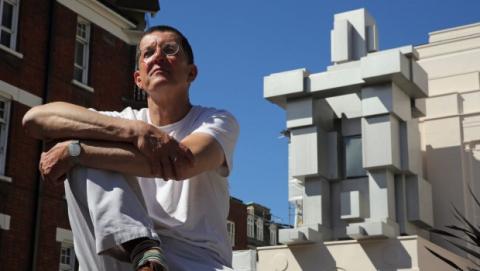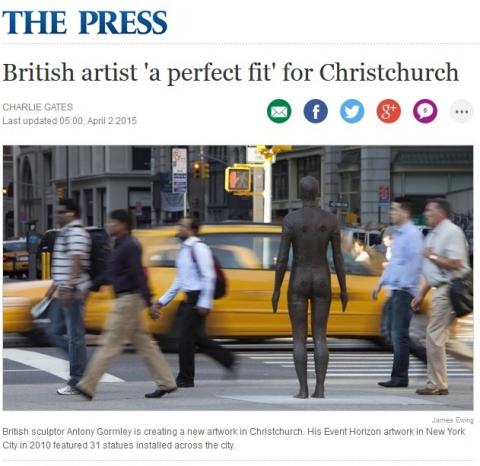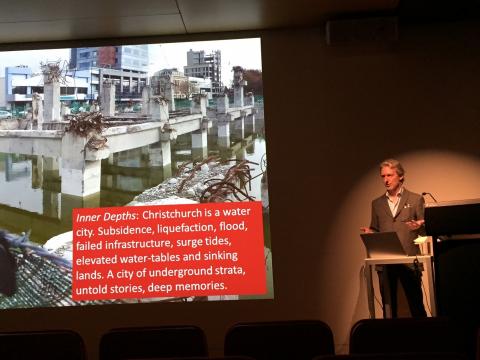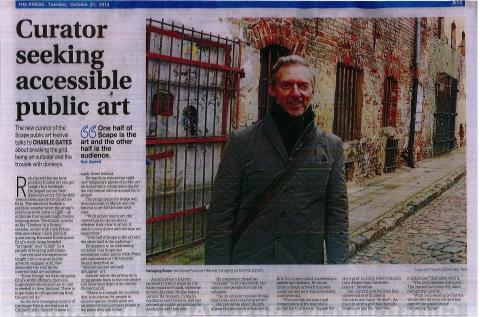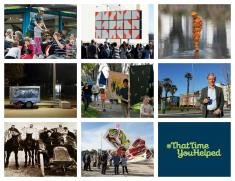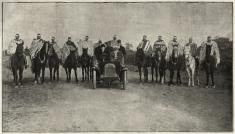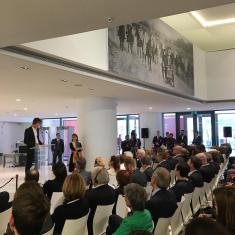Scape 8: New Intimacies
Public Art Christchurch Biennial
SCAPE 8 New Intimacies (October 3-November 15, 2015) ARTISTS: Nathan Pohio (NZ), Pauline Rhodes (NZ), Hannah Kidd (NZ), Fiona Jack (NZ), Judy Millar (NZ/DE), Peter Atkins (AU), Antony Gormley (UK) + #ThatTimeYouHelped (public PARTICIPATION project).
Curator's essay: New Intimacies in a water city
Dark matter now placed against a horizon. If minds live in bodies, if bodies live in clothes, and then in rooms, and then in buildings, and then in cities, do they also have a final skin, and is that skin perceptual? The horizon. And is art about trying to imagine what lies beyond the horizon? [1]
Christchurch became a water city. Subsidence, liquefaction, flood and failed infrastructure meant that water took on a renewed presence and significance for everyone (remembering that Christchurch, built on swampland, had always been a watery place). Some water cities occupy a romantic niche in the imagination; but Christchurch is not Italy’s Venice, Belgium’s Bruges, Mexico’s Mexicaltitan, China’s Zhouzhang or Benin’s Ganvie. Instead, the other popular myth in which water and a city collide, the sinking of Atlantis, has come to haunt the lived reality of people not just in Christchurch, but across the Pacific, with rising sea levels, tsunamis, floods, surge tides, elevated water-tables and sinking lands. In Christchurch, firm ground is hard to secure. This is the reality.
Being overwhelmed by water is also symbolic of the lived realities of the chaotic everyday circumstances and negative liquidity problems of late capitalism – drowning under debt, the inadequacy of insurance pay-outs and overwhelming rising costs. As well as being a physical presence and a social metaphor, water is a powerful symbol of the unconscious for those who wish to dig deeper into the human soul and spirit. In Christchurch, they will find depths of resilience and imagination that have proved necessary for finding ways ahead in life’s newly unstable terrain. For anyone facing a crisis on the scale of those in the post-earthquake city, tapping into the inner core, the deeper self, is necessary to simply stay afloat and then beyond that, to be able to think and act in new ways. But these problems need not define the city.
Thinking about the possibility of curating a SCAPE Biennial for 2015 it was necessary to believe that public art could be a part of navigating a way through, towards hope and optimism; and towards definitions of public life beyond seismic rupture and memory loss. Returning to Christchurch the year before the biennial after some years away, it was obvious how the city’s new appearance was playing tricks on the memories of locals and visitors alike, since the devastating earthquakes of 2010 and 2011. Standing in places once shaped by familiar landmarks but now empty tracts of gravel – a friend’s flat, a favourite café or bookstore – I wondered how new public art projects could, in some very modest way, help people form new, memorable and intimate connections – New Intimacies – within the fabric of the city as it was.
On the one hand I had always approached site-specific commissioning projects with a clear idea of the types of art practices, and in fact the very artists, that could potentially be a ‘good fit’ with what I found ‘on the ground.’ But being attracted to – and believing in – the works and thinking of certain artists isn’t enough; because the key question that moves me, and yes, also troubles me, is determining what sort of genuine connection there can be between the public art and the lived experiences of those people and communities who are the nominal ‘hosts’ – the locals. Regardless of whether the city is a disaster or a recovery city, a district in transition from chaos to order, from trauma to so-called normalisation, or not, that question still seems to me to be the fundamental question for any program of public art. How will artworks actually arise from, respond to, articulate and connect with the lived situations of those who call themselves ‘of this place’ – whether or not that is a recent or historical identification?
No matter how difficult this question might be to answer – and I do think in each specific instance it is a worryingly difficult question to answer with any conviction – it is a question that must be asked, before, during and after, for by being asked, with some urgency and much sincerity, it has the potential to change everything in the way we conceive, plan and realise such public art biennials.
The Christchurch situation seemed to demand both very hopeful and modest expectations and projects. While on the ground doing research for the biennial the rhetoric of Christchurch as a ‘transitional city’ pervaded everything, sometimes in strident slogans and other times drifting through the air like a faint scent. Every city is in some sort of transition, but disaster cities share an intensification of this sense of before and after, of during and following. They share the understandable desire to get out of the mess; to get beyond the chaos and to find some new order, calm, stability and betterment.
Despite SCAPE 8 occurring five years after the earthquakes which so changed Christchurch, many residents, especially in the East, were still in the midst of what they would call 'a disaster' – it was not yet behind them and the idea of real ‘transition’ for them seemed still a long way off. Leaking roofs, roads that had not yet been repaired, insurance woes, excruciating planning delays and suburbs that were newly and chronically prone to flooding all made for living conditions that were distressing and uncertain.
In disaster cities the rhetoric of transition is apt to the degree that it reflects an actual process of progressing towards a new order and calm. Yet the word can also be an obfuscation; because it can obscure the way many people’s lives either are not (yet) in transition ‘out’ of the trauma of the disaster, or for whom the disaster has actually ‘transitioned’ them into a worse position than before. Both of the latter were the case for some in Christchurch.
These realities, as well as the beauty of wildflowers quickly colonising demolition sites; the generous openness of people who shared their stories and insights; and the modest enthusiasm of the invited artists to contribute to the life of the city; all helped colour my thinking and about how to shape the biennial. I was also guided by the wishes of the SCAPE organisation for a small biennial focused on the centre of the city and the river precinct to draw people back to the city; understanding the reasons people were still largely avoiding the city centre four years on from the earthquakes – I still cry every time I think of going there, there’s nothing there for us, it’s just a dusty and noisy construction zone and extremely frustrating to navigate by car or on foot; hearing that despite this aversion to the ruined centre people would come in their 100os for the right event; experiencing the flattened and disorienting characteristics of the post-quake urban field; having an intuition that getting a balance between high visibility without monumentality, plus modest, or ego-less, artworks was going to be critical for SCAPE’s success as an experience or people; and possessing a great faith in the curiosity and openness of New Zealand public art audiences.
Reflecting on previous experiences curating public art programmes in urban environments where questions of homeliness, memory, forgetting and large-scale transformational forces all collided, also helped. I believe that art’s visual attractiveness, coupled with conceptual complexity and even a sense of the unfamiliar, together open new pathways in people’s imaginations. For Christchurch, the curatorial interpretation of the city’s situation, and thus the conceptual invitation to artists, came together as three fairly open-ended strands under the banner New Intimacies: Sight-lines, acknowledging the way the urban-scape had been flattened, opening up new, often disorienting landscape-like vistas (Antony Gormley, Judy Millar and Peter Atkins); Inner Depths, telling the story of changes to the city’s subterranean infrastructure as the land’s hidden strata re-asserted themselves (Pauline Rhodes) and evoking the symbolic realm of lost memories, untold stories and the city’s cultural layers (Nathan Pohio); and Shared Strengths, which turned its attention to people’s buoyancy, resilience and coping strategies (Hannah Kidd); the power of individual and collective helpfulness (#ThatTimeYouHelped); and the value of looking back – for instance, to the city’s avant-garde ‘Garden City Movement’ roots – in order to go forward with the collective task of designing and building progressive, new communities (Fiona Jack).
These approaches share an affinity with ideas about the transformative potential of public art. It is well-rehearsed that public art can make places more attractive, interesting, thought-provoking, popular and populated; and where artists are asked to respond to the local character of a place and are free to create challenging as well as playful works then the art can express and reflect the diversity of the local community in highly imaginative ways. But we were also interested in affective complexity and thought-provoking mystery, not just for their own sake, but because their deployment has the potential to make us aware of the ever-present gap between what we encounter in the world and what we think we know. Achieving this mix of elements, and the right balance between them, comes down to the range of artists and the ‘fit’ between each of these artists and the local contingencies, sites and curatorial themes; and the openness of participants and audiences. It is also about working with artists who have what I would call a ‘light touch’ in the public realm; namely that they know how to balance a strong concept with an openness to the ‘voice’ of the given in the local context, so that the artwork and the situation ‘speak’ with equal force for those who encounter the artwork. In such cases the art is both a direct experience in its own right and an encounter that connects to place, people, ideas and affect in ways that bring these external elements into sharper focus.
References:
[1]. Gormley’s notion of “dark matter” – an inner-being-spatial consciousness – has an aqueous dimension: it is a matter that flows outward until it reaches a perimeter, a binding force, a far horizon. Like water, it always finds place to seep, flow and pool. Transcribed from Antony Gormley: Sculpted space, within and without, TEDGlobal 2012. Filmed June 2012.
The Projects
Artists:
Nathan Pohio (Kati Mamoe, Ngai Tahu, Waitaha / NZ, Christchurch)
Pauline Rhodes (NZ, Christchurch)
Hannah Kidd (NZ, Methven)
Fiona Jack (NZ, Auckland)
Judy Millar (NZ, Auckland / Berlin)
Peter Atkins (AU, Melbourne)
Antony Gormley (UK, London)
Participation project:
#ThatTimeYouHelped – Our Portraits of People Reaching Out to One Another – public participation / online gallery
Nathan Pohio was commissioned for SCAPE 8 New Intimacies to conceive a large light-base work that would speak to the untold or forgotten stories of Christchurch's cultural pasts; and stand in direct relation to the narrow river that runs through the city. His resulting work was Raise the anchor, unfurl the sails, set course to the centre of an ever setting sun! (2015), a double-sided light box installed in Rememberance Park, Christchurch between an old Ngai tahu burial ground and the re-building cetral city. The work reproduces a photograph recording the visit of the British Governor General and his wife, Lord and Lady Plunket, to Tuahiwi. The site is home to Ngāi Tūāhuriri and played a vital role in Ngāi Tahu history. Pohio sourced the image from a 1905 edition of the Canterbury Times. In it Māori leaders on horseback in full ceremonial dress, korowai and kākahu (cloaks), are flanking Lord and Lady Plunket in their car. That day the Ngāi Tahu land claim was brought to vice-regal attention and a kete was presented to Lady Plunket. [Image credit: Māori in native costume escorting his Excellency Lord Plunket, 31 May 1905, C I Jennings photograph, Canterbury Times publication, Bishop Collection, Canterbury Museum Ref: 1923.53.747. Courtesy of the artist and Canterbury Museum.]
Following the Biennial, Nathan Pohio was selected as a finalist for New Zealand's premier art award, The Walters Prize, for his SCAPE8 project.
Raise the anchor, unfurl the sails, set course to the centre of an ever setting sun! (2015) was selected for documenta 14 (2017). This is the first time that New Zealand artists have exhibited at Documenta; and Nathan Pohio presented two versions of the work, a 2017 version for Athens exhibited at the main entrance of The National Museum of Contemporary Art (EMST), in Athens, Greece; and the 2015 light box for Kassel, Germany.
Pauline Rhodes, Mobile Tangles, 2015 (daylight concept image). 3 street-side installations at sites between Ōtākaro / Avon River and Hagley Park, Christchurch, SCAPE 8 New Intimacies commission. Courtesy of the artist.
Hannah Kidd, Mrs Parsons, 2015 (work in progress) - one of four figures titled Avonside Drive commissioned for SCAPE 8 New Intimacies and installed at Re:START Mall. Photo by Nick Taylor. Courtesy of the artist and Milford Galleries Dunedin.
Ōtākaro Plant Parade is a new artwork by Fiona Jack developed for SCAPE 8: New Intimacies. Fiona spent time in Christchurch talking with people and learning about ecological stories and histories of the Garden City. Along with some local collaborators, Fiona handmade a number of banners that weave a web of connections across the flora and social groups of Christchurch, from the historic trees planted by Samuel Barker along Oxford Terrace, to the daffodils which appear every year through the efforts of the Christchurch Beautifying Association; from the Cabbage tree at Burnside High School to the self-seeding weeds that occupy the city’s vacant lots. The procession: Individuals, families, members of societies and lovers of plants are invited to join the parade (October 4, 2015), to bring along their own banners, dress up, or take their pot plants for a walk. [Image: Fiona Jack, Ōtākaro Plant Parade, 2015 (Concept image). Photo by Darren Glass. Courtesy of the artist.]
Judy Millar, Call me Snake, 2015. Armagh Street opposite New Regent Street, Christchurch, SCAPE 8 New Intimacies commission, (artist's concept montage). Courtesy of artist and Gow Langsford Gallery.
Peter Atkins, Under Construction - Chaos and Order, 2015. Christchurch, SCAPE 8 New Intimacies commission, (artist's concept render, night). Courtesy of the artist.
Read "A conversation with Peter Atkins" in OCULA (September 24, 2015) here...
Antony Gormley, STAY, 2015. SCAPE 8 New Intimacies commission with support from the Christchurch City Council Public Art Advisory Group. Figure 1 (of 2): Ōtākaro / Avon River (October 2015). The second Figure will be installed in The Arcades, Arts Centre in early 2016; Christchurch, New Zealand. Images courtesy of the Artist. Photos by Bridgit Anderson and Rob Garrett.
#ThatTimeYouHelped – Our Portraits of People Reaching Out to One Another – is a SCAPE 8 New Intimacies public participation project in partnership with the All Right? Campaign team in their work to support Cantabrians' mental health and wellbeing.
The aim of the project is to provide a platform for locals to celebrate and honour those in their midst who have helped one another, and who will continue to do so, well beyond the urgent predicaments of the Christchurch earthquakes. Our people reaching out to one another.
How to get involved: Upload a photo to your Instagram or the That Time You Helped Facebook page of someone you think embodies the local spirit of helpfulness and kindness, using #ThatTimeYouHelped, and tell the world the story of their everyday kindness.
Video
Selected Reviews & Media Responses
Review
Warren Feeney on SCAPE 8 for The Press, Christchurch: "Invited curator Rob Garrett brings significant experience through his background in international public art to the current event; the inner city has more open spaces (for better and worse); good decisions have been made about the location of artworks and Scape seems more conscious of encouraging residents to rediscover the city." Read more here...
Opinion
Christopher Moore on SCAPE 8 in The Press: "Several weeks ago, I expressed disquiet about placing SCAPE 2015 in the central city.
I had serious misgivings about the wisdom of curating contemporary public art works in an urban vacuum. It would take, I suggested, works of considerable presence to dominate this challenging environment and attract the public's attention – and let's never forget that the public remains the ultimate and the best critic of an event like SCAPE.
Returning to Christchurch after a month in Sydney, I was delighted to see that SCAPE's visiting guest curator, Rob Garrett and the artists rising to the challenge in style. There's nothing shy or diffident about this year's biennale. It's a catalogue of strong, assertive, playful and witty works to engage the city's collective eye." Read more...
Review
Warren Feeney on SCAPE 8 for EyeContact: "If SCAPE 8's agenda is about normalising the experience of a newly, changing city then its timing is perfect. It may have taken a natural disaster on an extraordinary scale, but Christchurch residents and City Councillors seem to have acquired an unparalleled understanding and appreciation of the visual arts." Read more...
Eva Radich talks with Rob Garrett about the artists commissioned for #SCAPE8 and how they responded to the invitation and opportunity to make projects for Christchurch. Radio NZ Concert "Upbeat" programme; September 28, 2015. Listen...
LINK to TVNZ OneNews item (September 21, 2015) with Hannah Kidd and Nathan Pohio interviews and Antony Gormley preview. #HannahKidd #NathanPohio #AntonyGormley
Rob Garrett interview on Yale University Radio with Brainard Carey @wybcx @SCAPE_NZ #curator http://t.co/KrvCL6T1Ut pic.twitter.com/Ng5bF3jZnw
— rob garrett (@robgarrettcfa) July 3, 2015LINK to Yale University Radio WYBCX audio of Brainard Carey's interview with Rob Garrett.
What lies beyond? Art News New Zealand editor Dan Chappell talks to artist Antony Gormley and curator Rob Garrett in the lead up to SCAPE 8. Winter 2015 issue, pp74-78.
Scape to offer a sense of place, Warren Feeney talks to Scape 8 curator, Rob Garrett; The Press, April 13, 2015. "Contemporary art has the potential to connect people to a sense of place and belonging..."
Antony Gormley scuplture a coup for Christchurch, by Chris Moore, The Press, April 14, 2015. The announcement that the British sculptor, Antony Gormley, will create a new permanent public artwork for the city is welcome news...
Rob Garrett said Gormley was a perfect fit for Christchurch. "He is very aware of the Christchurch experience and what it has gone through and was touched to be asked to do something at this time..." [Published by The Press: British artist ‘a perfect fit’ for Christchurch, by Charlie Gates; April 2, 2015.]
April 2015: Invited artists and curatorial themes announced in lecture tour
- 6:00pm, Wednesday, 1 April, The Physics Room, Christchurch
- 7:30pm, Wednesday, 8 April, Dunedin Public Art Gallery; presented in conjunction with Dunedin Public Art Gallery
- 6:00pm, Thursday, 9 April, City Gallery Auditorium; presented in conjunction with City Gallery Wellington
- 6:00pm, Wednesday, 15 April, Auckland Art Gallery Auditorium; presented in conjunction with Auckland Art Gallery
Rob Garrett, Curator of SCAPE 8, presented a series of public talks in New Zealand in April 2015 to introduce the curatorial themes for the biennial in the context of the city’s present situation. In these talks he discussed the artists who have been commissioned to develop major new projects for SCAPE 8 and his rationale as curator for their selection for a city that finds itself in the ambivalent position of daily wrestling with the legacy of the earthquakes and recovery arrangements as well witnessing week-by-week the evidence of energetic rebuild activity. SCAPE 8 takes place in central Christchurch from 3 October to 15 November 2015.
October 2014: SCAPE 8 curator announcement
SCAPE Public Art is excited to announce Rob Garrett as the Managing Curator for the 8th SCAPE Public Art Christchurch Biennial that is to be held from 3 October to 15 November 2015.
“Rob Garrett comes with an extensive career curating and managing public art programmes and projects within New Zealand and internationally. We are delighted to be working with him and look forward to the exciting programme that he will be developing to engage, stimulate and excite the people of Christchurch and visitors in 2015” says Deborah McCormick, Director of SCAPE Public Art.
As Managing Curator for SCAPE 8, Rob Garrett will lead the overall curatorial strategy development, select artists, match artists to sites and participate in planning processes to shape concepts throughout the stages of development towards commissioning.
SCAPE 8 will see the installation of a public art walkway spanning over more than 21 sites, which will feature eight new large-scale and ambitious artworks along with the legacy and existing artworks that SCAPE Public Art has already realised, an education and community engagement programme and a series of public events. The SCAPE 8 public walkway will be available for viewing over a period of six weeks from 3 October to 15 November 2015 and aims to not only activate and enliven publicly accessible spaces but also add a high level of creativity and artistic expression to Christchurch’s rebuild landscape. Rob Garrett will work with local, national and international artists and industry partners to produce eight new temporary artworks that will be installed during SCAPE 8, six of which will be by local and national artists and two by international artists.
“It is wonderful to be invited to curate an edition of the SCAPE Christchurch Biennial which already has such an excellent standing locally and internationally” says Rob Garrett. “It is also a particular honour to be part of Christchurch getting back on its feet; I am looking forward to developing a programme that is inspiring yet also connected with people’s everyday realities.”
The overarching goal of SCAPE 8 is to deliver artistically excellent artworks that are a result of close collaboration between the art and business sectors of New Zealand while delivering art that engages, delights and excites the public of Christchurch in dynamic and interactive ways. Rob Garrett will be working alongside the SCAPE Public Art Team and Christchurch’s Art Stakeholders to develop and maintain the artworks and educational programmes of SCAPE 8 for a period of six weeks.
"Curator seeking accessible public art", profile interview of Rob Garrett for The Press (Christchurch's daily newspaper), 21 October 2014, page A13.
